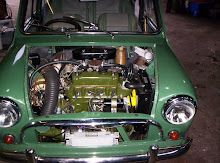Sunday, 18 October 2009
When the Oil Warning Light Glows
The oil-pressure switch on the crankcase normally opens when the pressure in the system exceeds 5-8 lb per sq in., so that the green warning light should be extinguished whenever the engine is running. If the light continues to glow or suddenly comes on at normal running speeds, the cause (apart from a faulty pressure switch, which is a possibility that cannot be entirely ruled out) is either a dangerously low oil level in the sump or loss of pressure at some point in the system.
If an oil pressure gauge and adaptor are substituted for the switch, a pressure of at least 40 lb per sq in. should be recorded when the engine is thoroughly warmed-up and running at a fairly fast speed; about 15 lb should be shown at idling speed. Incidentally, it is possible to fit an oil gauge and at the same time to retain the warning light if the oil-pressure switch is replaced by a special oil-filter adaptor, to which the pressure gauge pipe can be connected.
Assuming that the sump is full and that the correct grade of oil is used, low oil pressure can be caused by a choked intake in the sump, a faulty oil-pressure relief valve or a worn pump.
Fortunately the pump is seldom at fault (except when the engine has covered a very large mileage). The oil-pressure relief valve is, however, a possible culprit. This valve, which opens at 70 lb per sq in., relieves the excessive pressure that would otherwise be developed in the system when the oil is cold, is retained by a hexagon plug beneath the oil-pressure switch (see Fig. 10). The valve should be removed and cleaned. The seating in the cylinder block should also be cleaned with a lint-free cloth wrapped around the end of a length of wood. If the strength of the spring has weakened a new spring should be fitted. The valve is not adjustable.
If satisfactory pressure is not restored when the above points have been attended to, the crankshaft and connecting-rod bearings are probably badly worn.
Labels: light glows, mini car care, oil warning
Posted by Info Mini Cars at 04:02
Subscribe to:
Post Comments (Atom)



0 comments:
Post a Comment